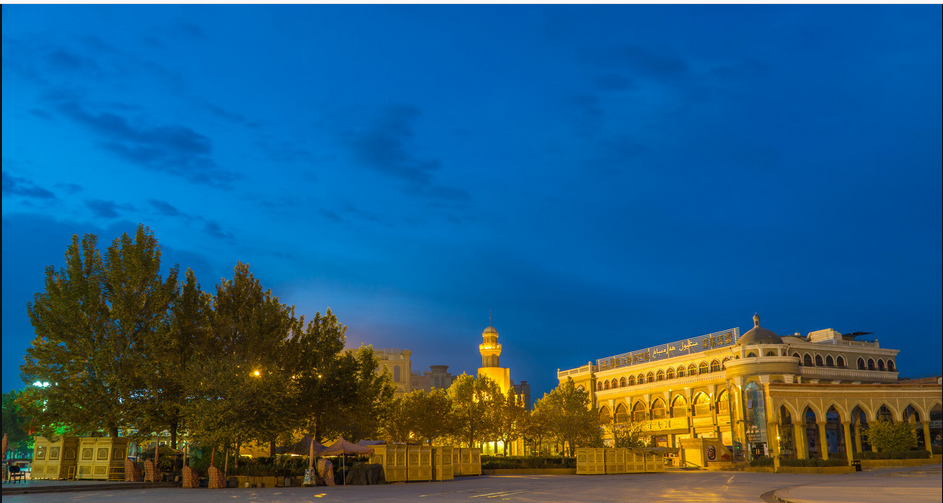Chinese Name: 艾提尕尔清真寺 Pronunciation: ài tí gǎ ěr qīng zhēn sì
Occupied Area: 16,800 square meters
Building Time: 1442
Suggested Visiting Hours: 1-2 Hours
Best Visiting Time: August, September, and October
Admission Ticket Fare: 20 yuan for tourists, free for Muslims
Address: West side of Id Kah Square, Kashgar, Xinjiang Uygur Autonomous Region
Popular Activities: Muslims worship in the mosque, which is also a gathering place for Muslims to celebrate other big festivals.
Building Function: During Zhengtong period of the Ming Dynasty (1436-1449), the ruler of Kashgar, Shaksezi Mirza, was buried here, and his descendants built a small mosque, which was later developed into the Id Kah Mosque.
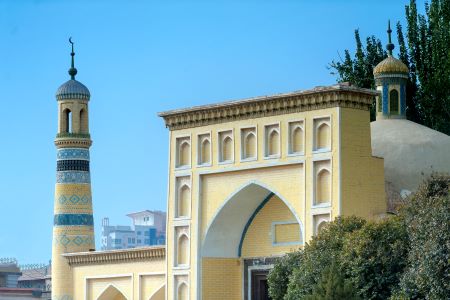
“Id Kah” means “festival, a square for celebrating and worshiping”. Mosque is a place where Muslims hold religious activities and a "place of worship" for Muslims to worship. Chinese and foreign tourists to Xinjiang will find that there are many mosques of different sizes in the streets and alleys. With the development of Islam, mosques have more functions.
Worship plays an indispensable role in Muslim religious life, so where Muslims gather, there are mosques. At present, in Xinjiang, there are more than 22000 Islamic mosques and places for religious activities.
The Id Kah Mosque is an ancient Islamic architectural complex with rich ethnic styles. It is not only the largest mosque in Xinjiang, but also one of the largest mosques in China. Also, it is the center of Islamic activity in Xinjiang, which was built in 1442 and rebuilt and expanded afterwards to have the scale it is today.
The big temple is majestic and strictly regulated. The gate building of the brick arched square arch door is 12 meters high, and the side ring is surrounded by 15 dome-shaped buildings. The main entrance of the mosque is light green with fine engravings; the grand temple of worship and the scripture hall are full of Islamic characteristics.
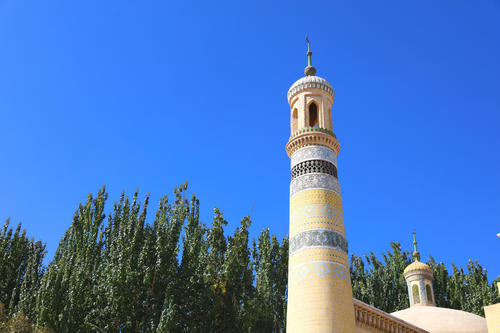
The Id Kah Mosque has a total area of 16,800 square meters and consists of a house of worship, a lection-teaching hall, a gate tower and some other auxiliary buildings.
The gate tower of Id Kah Mosque is facing Id Kah Square. The mosque gate is made of yellow brick with plaster seams. The main gate is 4.7 meters high and 4.3 meters wide. The gate tower is about 17 meters high. There is an 18-meter-high minaret asymmetrically built on both sides of the gate tower, with a crescent on its top. At dawn, an Imam in the mosque ascends the minaret five times and summons outside Muslims to come to worship. There is a fan-shaped 13 steps in front of the door. Walk up the steps and then you can see two grand wooden doors wrapped in brass.
On the wall above the mosque gate is a huge platform which is 8 meters long and 10.5 meters above the ground. When grand festival is coming, the sound of sheepskin drums and lock music ringing through the sky all day and night will be heard on the platform, creating a happy festive atmosphere for the more than tens of thousands of Muslims who gathered in Id Kah Square.
When entering the gate, there is the huge dome Gongbaizi(one characteristic architecture). Below the Gongbaiz is a polygonal courtyard. There are two passageways leading to the courtyard of the mosque, with a carved window sandwiched between the two passageways. Gongbaizi is 16 meters high and 10 meters in diameter. Walking out of the passageway on the north side of the courtyard, there is a path with a width of 4.38 meters and a length of nearly 80 meters, with terrazzo pavement. Trees are planted on both sides of the road, and there are two pools on the north side of the road. The big pool is 42 meters long from east to west and 17 meters wide from north to south, showing an irregular rectangle. On the west side of the big pool, there is a small pool near the terrazzo path. It is 17 meters long from east to west and 16 meters wide from north to south, which is approximately square. The poplars tower around the two pools, and mulberry and elm trees grow luxuriantly. Although the mosque locates in the centre of the city, the Mosque is particularly quiet and elegant.
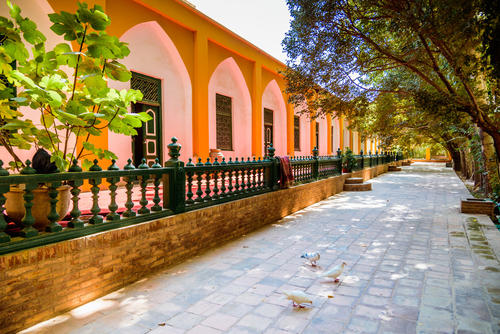
The house of worship locates in the western end of a large mosque courtyard, separated by a fence. The house of worship is divided into three parts: the main hall, the outer hall and the entrance of the hall, all of which are built on the platform foundation which is more than one meter above the ground. The length from north to south is 140 meters, and the width from east to west is 19 meters. The outer hall has 140 green carved wooden columns up to 7 meters high arranged in a grid pattern, supporting the white ceiling. It shows a magnificent and neat momentum. The top of the mosque is supported by 158 light blue pillars in a square shape. The ceiling and the four corners of the pillars are beautifully carved and painted. On the central wall of the main hall, there is a niche with a sedan chair inside. When Muslims are doing worship, the mullahs will stand in the niche. If there is a festival, the giant mullahs will preach here.
On the north and south sides of the chapel, there are lection-teaching halls. It has 24 lection-teaching halls with 11 in the south and 13 in the north. Between the lection-teaching halls, there are two doors on northern and southern respectively, which are used for people to go in and out at ordinary times. There are wooden fences at the back of the courtyard. On the east side of the fence, there are two minarets on the north side and south side of the passageway. The tower is 6.5 meters high, and the bottom of the tower is 3 meters long and 2.2 meters wide. The total length of the fence is 115 meters. There are five wooden doors to the main hall. The wooden fence is 2.9 meters high, the brick columns are 3.1 meters high, the door of the fence is 4.1 meters high, and the columns on both sides are 5.2 meters high. Go through the five gates of the fence to enter the chapel, and then walk five steps to get into the house of worship.
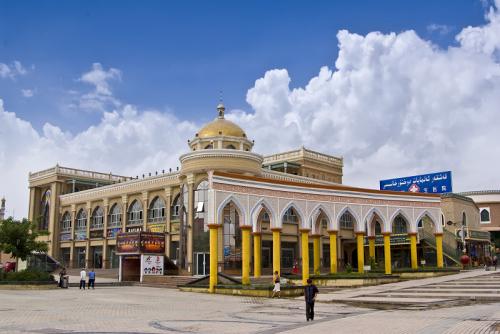
The main hall of the house of worship is 36.5 meters long, 10.5 meters wide and 8.1 meters high. There are two gates on each side of the east wall for people to enter and exit. And in the middle is a Mihelapu (it is the arched pattern on the wall), which is 1.8 meters wide and nearly 4 meters high, with two windows on each side. The west wall of the main hall also has a Miholapu, 4.3 meters high and 3.1 meters wide. There is a platform for the grand mullahs to preach.
The south wall and the north wall of the main hall have two doors and a window respectively. There are 18 pillars in the main hall. The north and south sides of the main hall are the outer halls, and there are fourteen niches on the west wall of the north outer hall and four on the north wall. There are eleven niches on the west wall of the outer hall on the south side and four on the south wall. Between the seventh and eighth niche, there is a double door which is the back gate of the mosque. Inside there is a small courtyard and there is a door on the west wall of the small courtyard which leads to the outside. The back gate is usually used to transport bodies and is only opened on “Juma Day”(A special day named after a patriot Juma).
There are five dome-shaped colored ceilings on the north side of the outer hall and four on the south side. It is 3.6 meters long and 3.2 meters wide. There is a dome-shaped colored ceiling on the front porch of the main hall. It is 6.6 meters long and 5.5 meters wide. The outer hall has 122 columns. The bottom and body of the columns are carved and painted. The base of the column is 35 to 40 cm. The height of the front porch of the main hall is about 5.4 meters, and the height of the columns on both sides is about 5.1 meters.
All people are equal here, regardless of status, beggars or rich men. The people who come earlier can kneel in the front of the hall and who come later can only kneel at the back of the hall or outside the hall. Nothing matters in front of religion. Everyone can equally listen to the imam’s preach of the Koran.
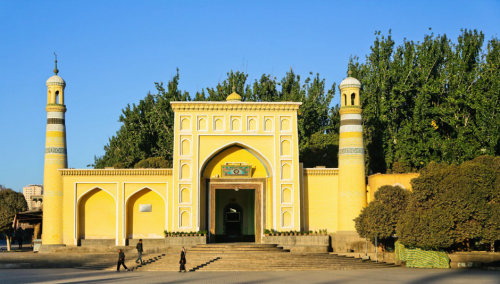
In 1442, the king of Kashgar, Shaksezi Mirza, first established a mosque here. It was during the reign of the Dugrat family Said Ali of the Eastern Chagatai Khanate in Kashgar (1435 -1457). At that time, the site of the monastery was still a reed beach outside the city. Said Ali’s eldest son Sonnis Mirza first built a small mosque on the site of the Id Kah Mosque.
In 1538, the ruler of Kashgar, Ubuli Aduik, extended the monastery to commemorate his late uncle.
In the 16th century, the monarch of the Yarkand Khanate expanded it into a large mosque capable of worshipping the Lord.
In 1798 The Shah Uyghur Muslim female Muslim Guregena died in Kashgar on her way to Pakistan. People used her leftover travel expenses to expand the mosque and named it "Id Kah".
In 1809, Kashgar Akimbok (Official Title) Iskandar expanded the mosque by adding Gongbei-style temple gates, and dug artificial lakes and canals in the courtyard.
During the expansion of Kashgar City during the Daoguang Period of the Qing Dynasty (1821~1850), the Id Kah Mosque, which had been outside the city, was incorporated in the city.
In 1872, the Khanate of Kokand invader Yaqub Beg ordered a large-scale expansion of the mosque. Not only were the temple houses, warm rooms, baths, minarets, and artificial lakes added, but also the temple gates and worship halls were rebuilt, and the entire temple layout was re-planned to form the current scale.
If you go to the Id Kah Mosque from Kashgar International Airport, you can take Sightseeing Line 1 or Sightseeing Line 2 and get off at Id Kah Station. It takes about 45 minutes to get there.
If you go to the Id Kah Mosque from Kashgar Railway Station, you can take line 20 and get off at China Post Station; take line 28 and get off at Xinhua Bookstore; take line 29 and transfer at Mei Chang station to line 28, then get off at Id Kah Station. It takes about 25 minutes to get there.
If you go to the Id Kah Mosque from center of Kashgar, you can take line 2,7,8,13,22,28. It takes about 10 minutes to get there.
By Taxi
Chinese: 请带我去艾提尕尔清真寺。English: Please take me to the Id Kah Mosque.
If you go to the Id Kah Mosque from Kashgar International Airport, it takes about 25 minutes(45 yuan).
If you go to the Id Kah Mosque from Kashgar Railway Station, it takes about 15 minutes(25 yuan).
If you go to the Id Kah Mosque from center of Kashgar, it takes about 8 minutes(10 yuan).
